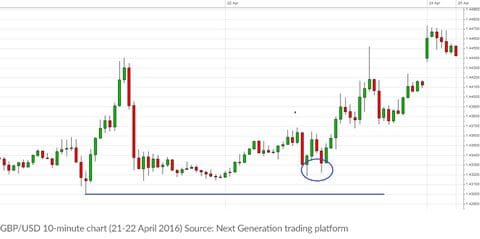Simple day trading strategies
Day trading is a popular short-term trading strategy, which involves the buying and selling of financial instruments with the aim of closing out of the positions by the end of the day to profit from small movements in price. Day trading strategies can differ from longer-term trading strategies, in that they focus more on profiting from shorter-term movements in the market, as opposed to moves that take place over a number of days or weeks.
The rise of the day trader
The idea of day trading has increased in popularity over recent years. Technology has played a big part in this – thanks to fast broadband and mobile connections we have a wealth of real-time market information at our fingertips. This has led to many more people trying to beat the market by day trading – placing trades throughout the day to try and profit from volatility as market prices swing up and down. But what are the best strategies to use? Keep it simple, or use something a bit more complicated?
Technical trading strategies
Many day traders use technical analysis and charts and would recommend a 'clean' approach to trading strategy. These traders prefer not to load their charts with lots of different indicators in order to try and second-guess direction. Rather, they will focus solely on price; this is often referred to as 'price-action trading'. There is definitely some merit to this and, when trading in this way, you still have some key reference points based on what has happened previously to help you plan future trades.
For some day traders the previous day’s high and low are important levels to watch when it comes to planning a strategy for today. This is actually quite logical: yesterday's high marked the point where sentiment changed and the sellers came back into the market and pushed the price lower. The market consensus was that the price was too high. And of course the previous day's low shows where the buyers regained confidence as they felt the market was undervalued – they voted with their wallets and bought. It is not too much of a stretch of the imagination to think that these levels could well be important if they come into play again, and this can be the cornerstone of a day trading strategy.
Example day trade: GBP/USD
The chart below highlights the simplicity of the strategy described above.

On the morning of 22 April, the day trader could look at the previous day’s high and low in the popular GBP/USD forex pair. During the day before, when the price dipped back to the 1.4300 level, the buyers came back in. Of course there was no way of knowing what would happen throughout 22 April, but there was a reasonable chance that 1.4300 could end up being an important level for that day's trading. The expectation would be for buyers to step back in again ahead of that 1.4300 mark.
Support and resistance
As can be seen in the chart, this is exactly what happened. There were actually two occasions over the course of a couple of hours where the GBP/USD rate slid back towards that level, trading down to 1.4320. The day trader would consider buying here as there had been demand on the previous day. Another big advantage of using absolute levels like this to plan trades is the all-important management of risk. Day trading is of course all about trying to make profits, but it's just as important to limit losses when things do not go as planned. If the GBP/USD rate slid below the 1.4300 level then clearly something has changed and the day trade could be exited for a small manageable loss.
Determining your best strategy
No strategy works all the time, but a simple day trading strategy like this can help pinpoint low-risk, high-reward trades at important points throughout the day. Some traders would also use the failure of one trade as an opportunity to set up another. If the level breaks (as the previous day’s high did later on in the session) it can signal a new trend is starting, presenting another opportunity to try and profit.
Become an educated trader
The above example of simply using the previous day’s levels highlights how a strategy does not have to be overly complex to still present at least one or two perfectly reasonable trading opportunities across many different markets. There are many different strategies that can be applied to day trading and a number of other factors to take into consideration. The best thing you can do to improve your chances of trading success is to educate yourself via the many written trading resources and trading strategy videos available.
Disclaimer
CMC Markets is an execution-only service provider. The material (whether or not it states any opinions) is for general information purposes only, and does not take into account your personal circumstances or objectives. Nothing in this material is (or should be considered to be) financial, investment or other advice on which reliance should be placed. No opinion given in the material constitutes a recommendation by CMC Markets or the author that any particular investment, security, transaction or investment strategy is suitable for any specific person.
CMC Markets does not endorse or offer opinion on the trading strategies used by the author. Their trading strategies do not guarantee any return and CMC Markets shall not be held responsible for any loss that you may incur, either directly or indirectly, arising from any investment based on any information contained herein.